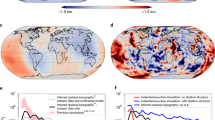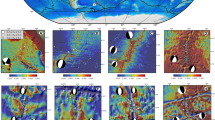Abstract
The negative free-air gravity anomaly centred on Hudson Bay, Canada, shows a remarkable correlation with the location of the Laurentide ice sheet, suggesting that this gravity anomaly is the result of incomplete post-glacial rebound1,2,3. This region, however, is also underlain by higher-than-average mantle seismic velocities, suggesting that the gravity low might result instead from dynamic topography associated with convective downwellings4,5,6,7. Here we analyse the global gravity field as a simultaneous function of geographic location and spectral content. We find that the Hudson Bay gravity low is unique, with anomalously high amplitude in the spectral band where the power from the Laurentide ice load is greatest2 and the relaxation times predicted for viable models of viscous relaxation are longest8. We estimate that about half of the Hudson Bay gravity anomaly is the result of incomplete post-glacial rebound, and derive a mantle viscosity model that explains both this gravity signature and the characteristic uplift rates for the central Laurentide and Fennoscandian regions6. This model has a jump in viscosity at 670 km depth, comparable to that in dynamic models of the geoid highs over subducted slabs4,9, but lacks a low-viscosity asthenosphere, consistent with a higher viscosity in the upper mantle beneath shields than in oceanic regions.
This is a preview of subscription content, access via your institution
Access options
Subscribe to this journal
Receive 51 print issues and online access
$199.00 per year
only $3.90 per issue
Buy this article
- Purchase on Springer Link
- Instant access to full article PDF
Prices may be subject to local taxes which are calculated during checkout


Similar content being viewed by others
References
Kaula, W. M. in The Nature of the Solid Earth (ed. Robertson, E. C.) 385–405 (McGraw-Hill, New York, (1972)).
Walcott, R. I. Structure of the earth from glacio-isostatic rebound. Annu. Rev. Earth. Planet. Sci. 1, 15–37 (1973).
Cathles, L. M. The Viscosity of the Earth's Mantle (Princeton Univ. Press, (1975)).
Hager, B. H. & Clayton, R. W. in Mantle Convection (ed. Peltier, W. R.) 657–763 (Gordon and Breach, New York, (1989)).
Peltier, W. R., Forte, A. M., Mitrovica, J. X. & Dziewonski, A. M. Earth's gravitational field: seismic tomography resolves the enigma of the Laurentian anomaly. Geophys. Res. Lett. 19, 1555–1558 (1992).
Forte, A. M. & Mitrovica, J. X. New inferences of mantle viscosity from joint inversion of long-wavelength mantle conveciton and post-glacial rebound data. Geophys. Res. Lett. 23, 1147–1150 (1996).
Pari, G. & Peltier, W. R. The free-air gravity constraint on subcontinental mantle dynamics. J. Geophys. Res. 101, 28105–28132 (1996).
Hager, B. H. in Glacial Isostasy, Sea-level and Mantle Rheology (eds R. Sabadini, K. L. & Boschi, E.) 493–513 (NATO ASI Ser. C. vol. 334, Kluwer, Dordrecht, (1991)).
Ricard, Y. & Vigny, C. Mantle dynamics with induced plate tectonics. J. Geophys. Res. 94, 17543–17559 (1989).
O'Connell, R. J. Pleistocene glaciation and the viscosity of the mantle. Geophys. J. R. Astron. Soc. 23, 299–327 (1971).
Mitrovica, J. X. & Peltier, W. R. Pleistocene deglaciation and the global gravity field. J. Geophys. Res. 94, 13651–13671 (1989).
Simons, M. thesis, MIT, Cambridge, Massachusetts((1996)).
Simons, M., Solomon, S. C. & Hager, B. H. Localization of gravity and topography: constraints on the tectonics and mantle dynamics of Venus. Geophys. J. Int. 131, 24–44 (1997).
Hager, B. H. Subducted slabs and the geoid: constraints on mantle rheology and flow. J. Geophys. Res. 89, 6003–6015 (1984).
Masters, G., Johnson, S., Laske, G. & Bolton, H. Ashear-velocity model of the mantle. Phil. Trans. R. Soc. Lond. A 354, 1385–1411 (1996).
Van Bemmelen, R. W. & Berlage, H. P. Versuch einer mathematischen behandlung geotektonischer bewegung unter besonderer berucksichtegung der undationstheorie. Beitr. Geophys. 43, 19–55 (1935).
Haskell, N. A. The viscosity of the asthenosphere. Am. J. Sci. 33, 22–28 (1937).
Forte, A. M. & Peltier, W. R. Viscous flow models of global geophysical observables. 1. Forward problems. J. Geophys. Res. 96, 20131–20159 (1991).
Forte, A. M., Woodward, R. L. & Dziewonski, A. M. Joint inversions of seismic and geodynamic data for models of three-dimensional mantle heterogeneity. J. Geophys. Res. 99, 21857–21877 (1994).
Lambeck, K., Johnston, P. & Nakada, M. Glacial rebound and sea-level change in northwestern europe. Geophys. J. Int. 103, 451–468 (1990).
Mitrovica, J. X. Haskell [1935] revisited. J. Geophys. Res. 101, 555–569 (1996).
Mitrovica, J. X. & Forte, A. M. Radial profile of mantle viscosity—results from the joint inversion of convection and postglacial rebound observables. J. Geophys. Res. 102, 2751–2769 (1997).
Nakada, M. & Lambeck, K. Glacial rebound and relative sea-level variations: a new appraisal. Geophys. J. R. Astron. Soc. 90, 171–224 (1987).
Nerem, R. S. et al. Gravity model development for TOPEX/Poseidon: joint gravity models 1 and 2. J. Geophys. Res. 99, 24421–24447 (1994).
Nerem, R. S., Jekeli, C. & Kaula, W. M. Gravity field determination and characteristics: retrospective and prospective. J. Geophys. Res. 100, 15053–15074 (1995).
Wessel, P. & Smith, W. H. F. New version of the Generic Mapping Tools released. Eos 76, 329 (1991).
Tushingham, A. M. & Peltier, W. R. Ice-3g: a new global model of late Pleistocene deglaciation based upon geophysical predictions of post-glacial relative sea-level change. J. Geophys. Res. 96, 4497–4523 (1991).
Hager, B. H. Global isostatic geoid anomalies for plate and boundary layer models of the lithosphere. Earth Planet. Sci. Lett. 63, 97–109 (1983).
Acknowledgements
We thank M. Fang, M. Gurnis and S. Zhong for constructive discussions, as well as J. X. Mitrovica for a thorough review. This work was supported by NASA.
Author information
Authors and Affiliations
Author notes
Correspondence should be addressed to M.S.
Corresponding author
Rights and permissions
About this article
Cite this article
Simons, M., Hager, B. Localization of the gravity field and the signature of glacial rebound. Nature 390, 500–504 (1997). https://doi.org/10.1038/37339
Received:
Accepted:
Issue Date:
DOI: https://doi.org/10.1038/37339
This article is cited by
-
Influence of the asthenosphere on earth dynamics and evolution
Scientific Reports (2023)
-
Global long-term observations of coastal erosion and accretion
Scientific Reports (2018)
-
Analysis of plate spin motion and its implications for strength of plate boundary
Earth, Planets and Space (2016)
-
Effects of water load on geophysical signals due to glacial rebound and implications for mantle viscosity
Earth, Planets and Space (2014)
-
Estimating geoid height change in North America: past, present and future
Journal of Geodesy (2012)
Comments
By submitting a comment you agree to abide by our Terms and Community Guidelines. If you find something abusive or that does not comply with our terms or guidelines please flag it as inappropriate.



